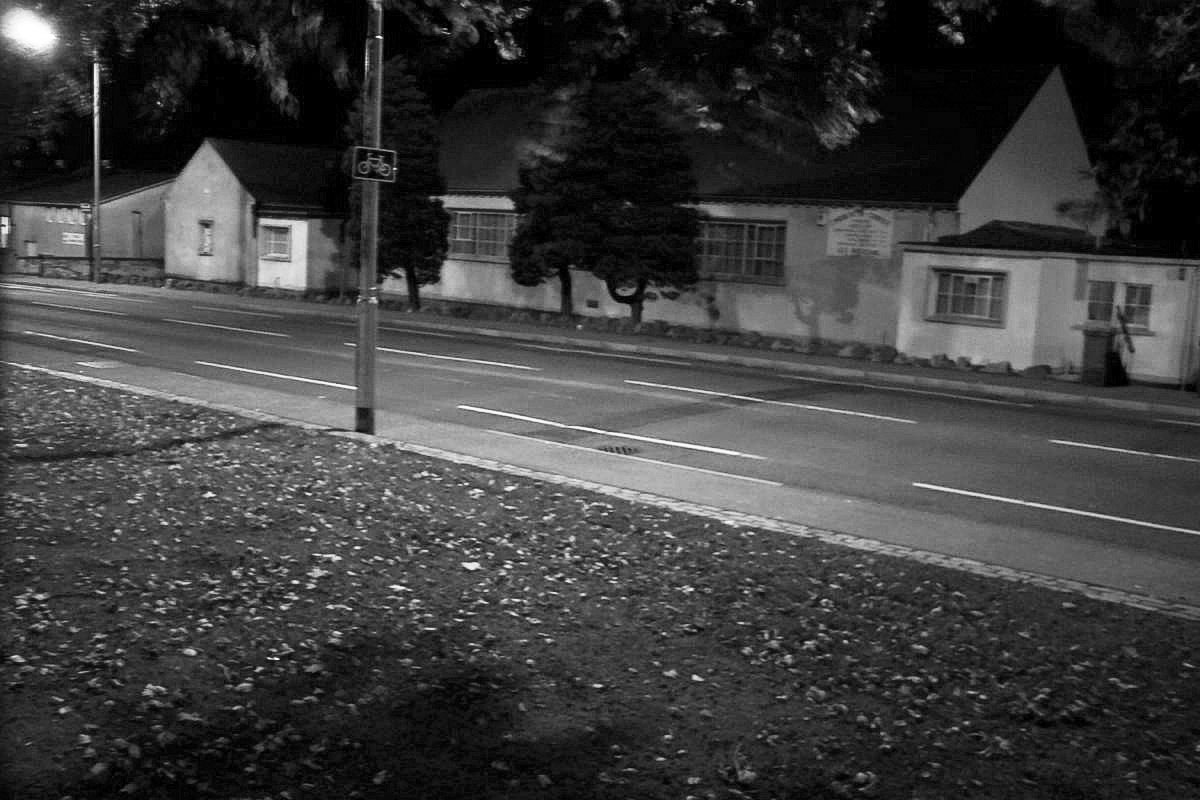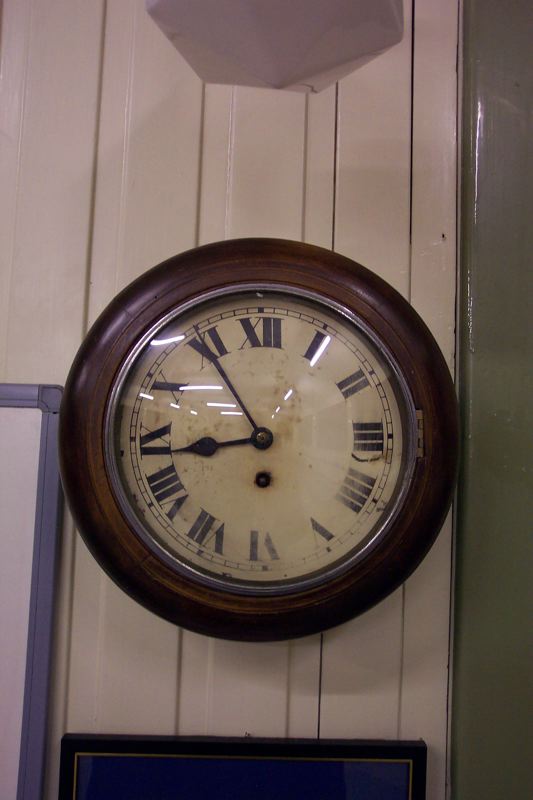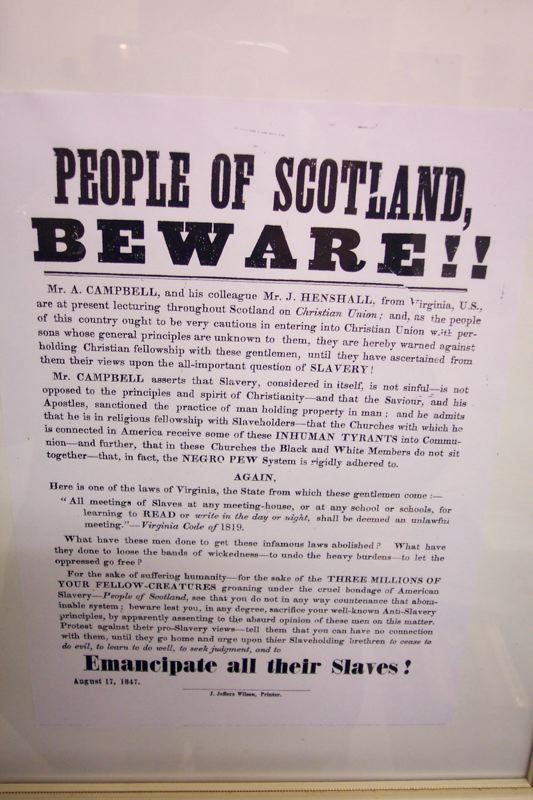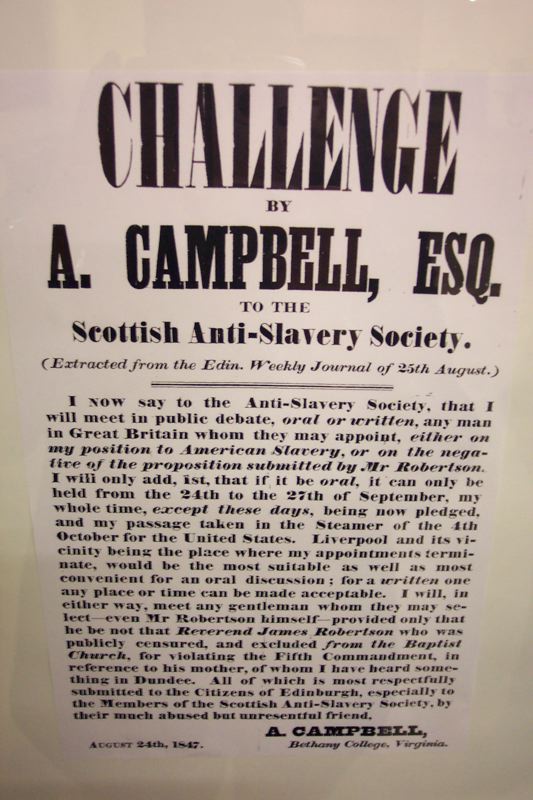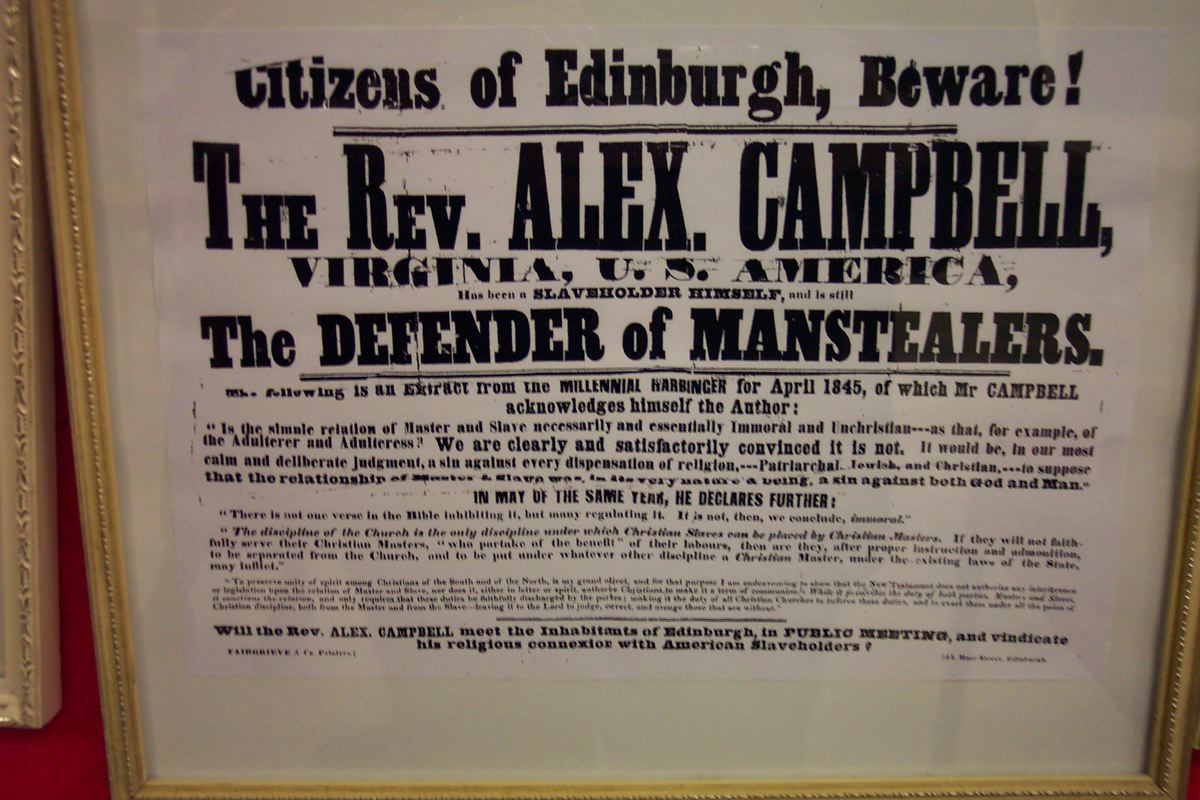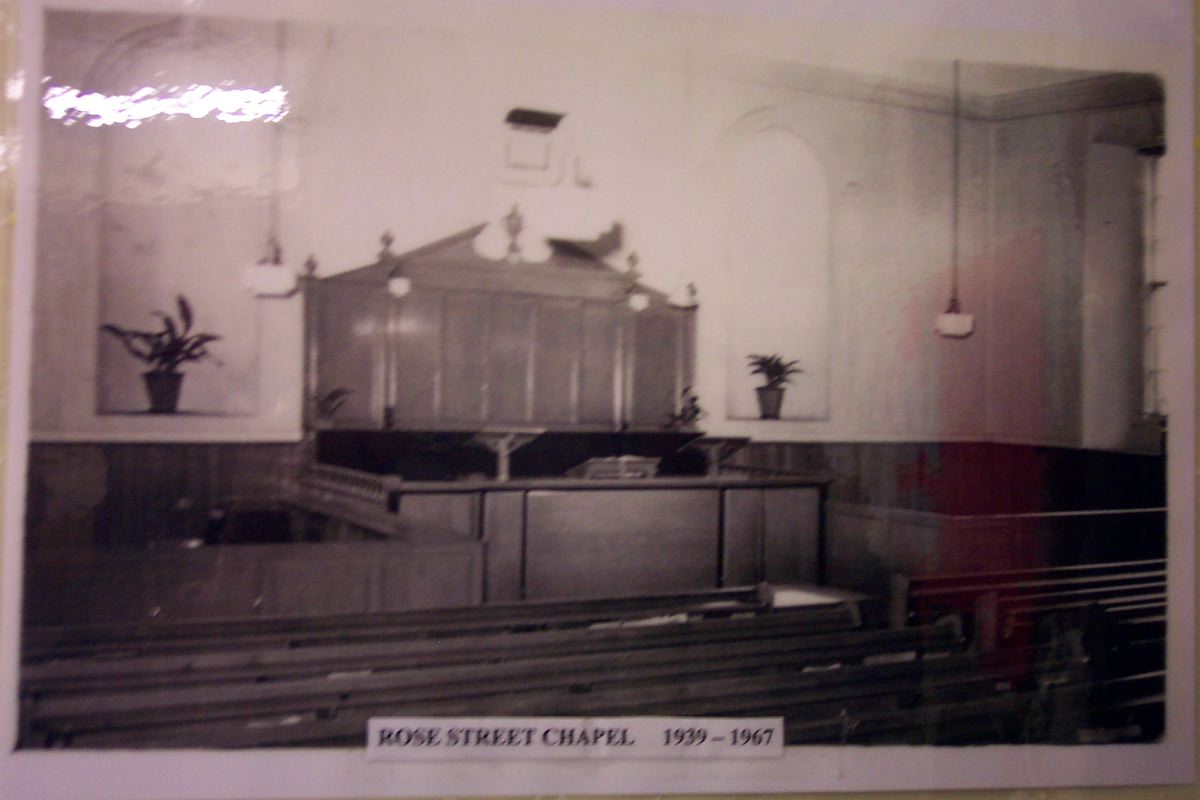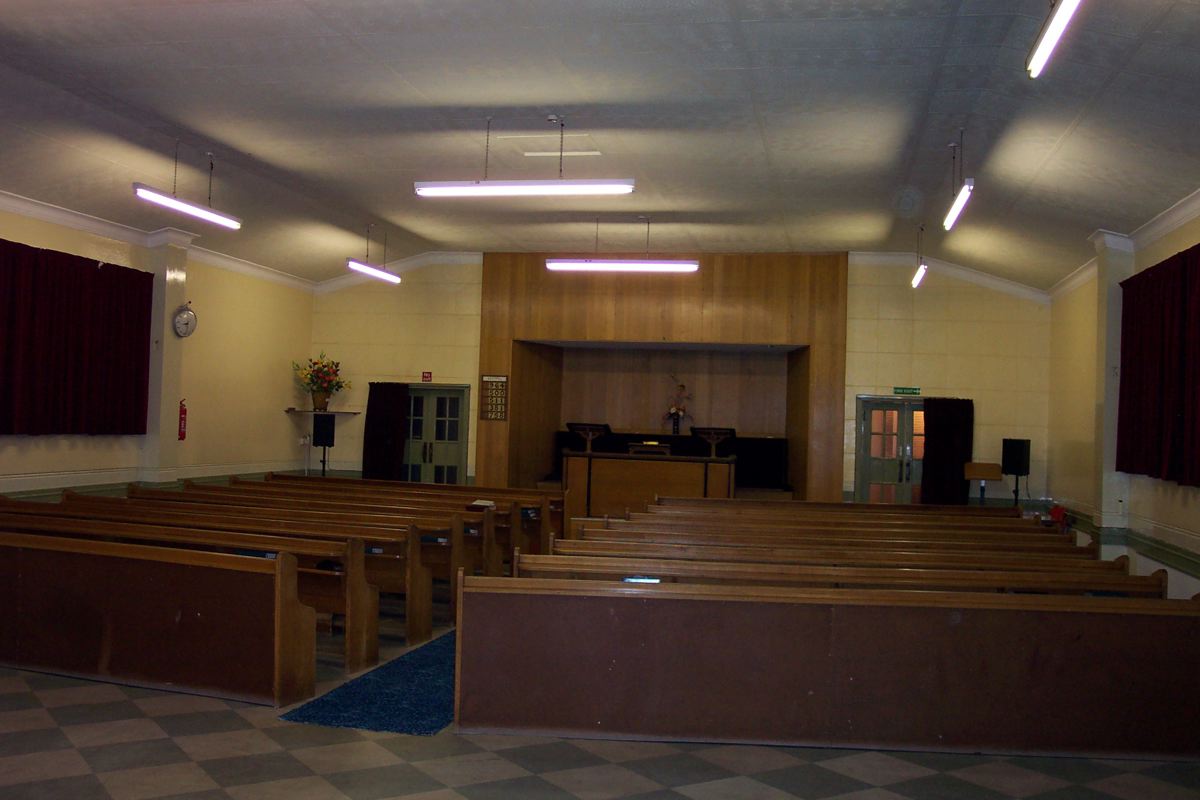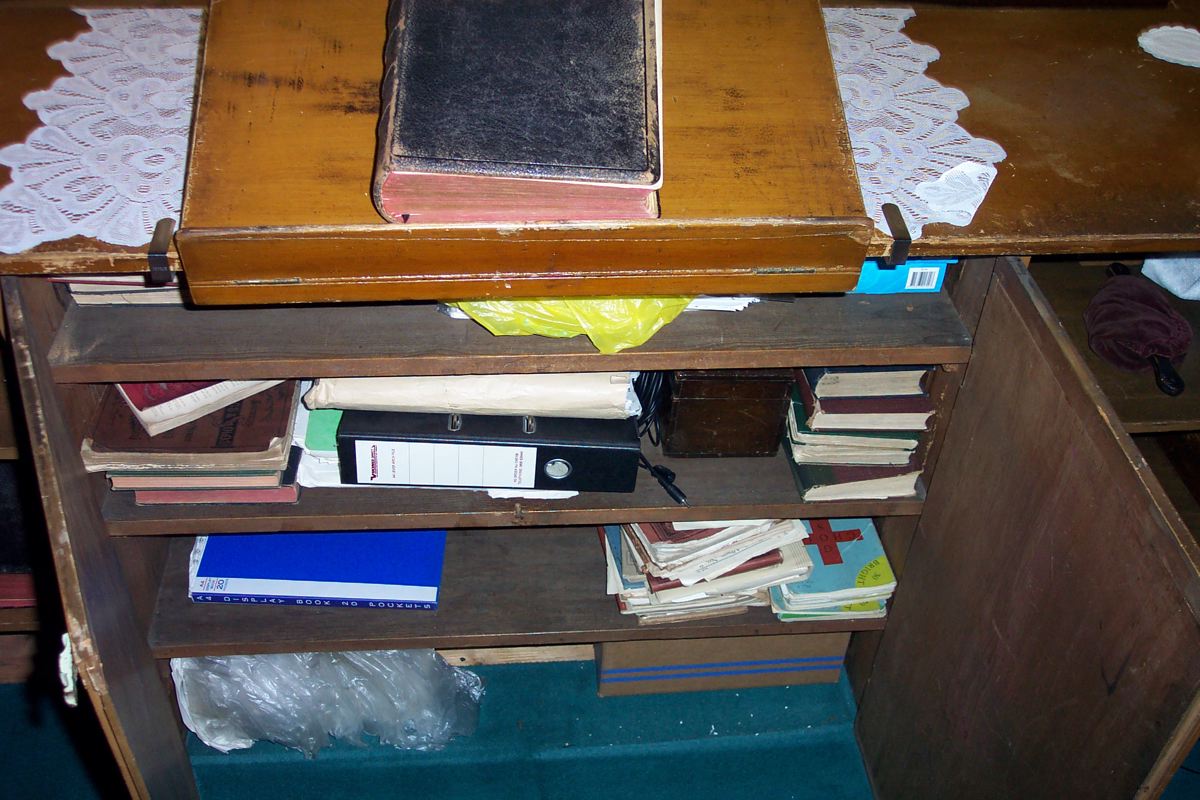Kircaldy Church Of Christ
1784-Present
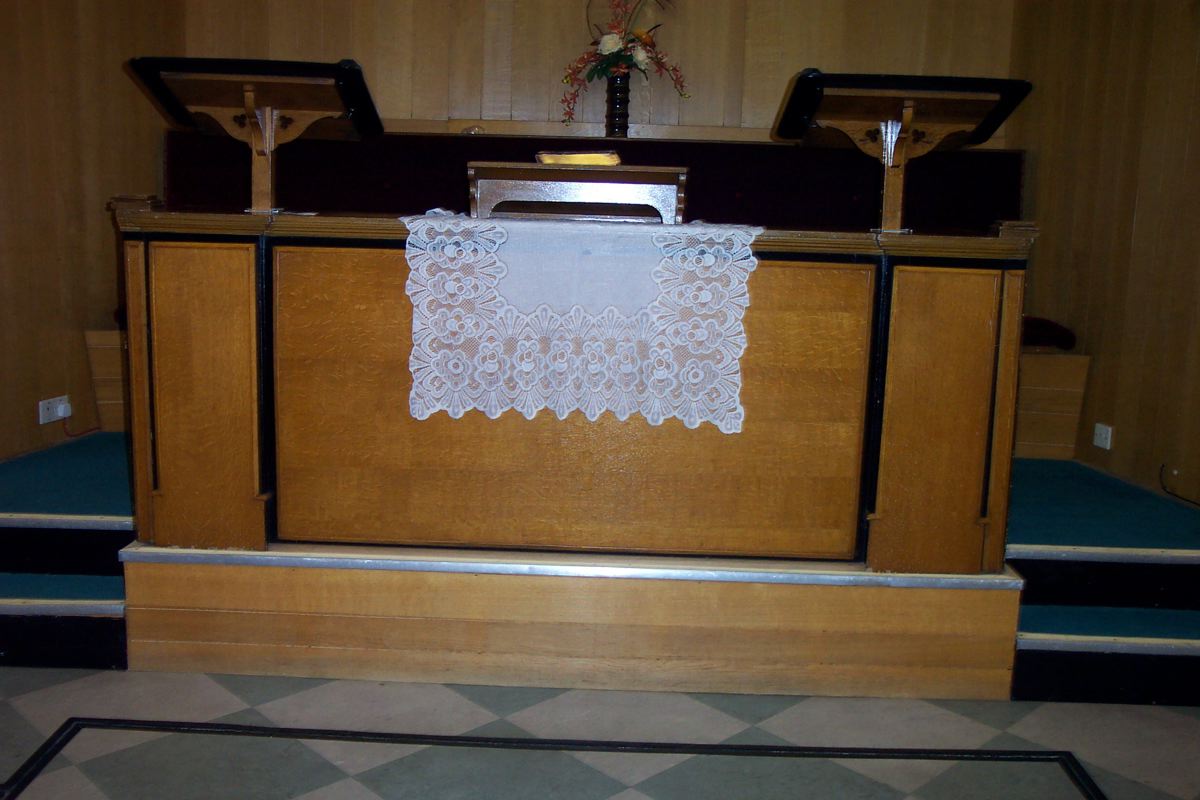
Pulpit that came from
the original Rose Street Chapel
Alexander Campbell preached from this pulpit in 1847
![]()
Kircaldy Church of Christ:
A Rich History
Robert Cannichael and Archibald McLean first met when they were members of the Glasite church in Glasgow. In the early 1760's Robert Carmichael had been a minister in the Anti-Burgher section of the Secession church in Coupar Angus until he adopted the views of John Glas. He became the pastor of the Glasite church in Glasgow in 1762.
Archibald McLean, a printer and bookseller in Glasgow, about the same time and for the same reasons left the established Church of Scotland and joined the Glasite church.
During their association Carmichael and McLean studied and discussed the subject of baptism. They later concluded that it should be immersion administered only to believing adults. Before they came to this conclusion, however, both withdrew from the Glasite church owing to an injustice which they deemed to have been committed.
Soon afterwards, Robert Cannichael moved to Edinburgh "to minister to an Independent body" but in May 1765 he, with seven others, withdrew on "a doctrinal matter."
Robert Carmichael's conviction on the matter of baptism grew and, finding that he had no knowledge of any "baptist" in Scotland, went to London and was baptised at the Barbican on the 9th October 1765. Returning to Edinburgh he baptised five of the seven who withdrew with him from the "Independent body" and some weeks later Archibald McLean was also baptised. In this way the Scotch Baptist movement came into being. They worshipped in the Magdalene Chapel in Edinburgh's Cowgate, which they rented, Robert Carmichael being appointed pastor of the congregation. Many people were added to that church, corning from as far as Glasgow and Montrose, until churches were established in these towns.
In May 1769 Robert Carmichael moved to Dundee to establish a church in that city leaving Archibald McLean and others to oversee the work in Edinburgh.
From this original Scotch Baptist church [now known as the Bristo Baptist church, and now part of the Baptist Union of Scotland] came support for the work in Kirkcaldy, probably the fifth "daughter" church to be established. The Edinburgh church was referred to, by the Rose Street church, as the "mother church", until the time when elders were appointed in 1798, at which time the Rose Street church became independent.
1784/6 to 1849
Kirkaldy [spelt without the "c" in those days] was, at the end of the eighteenth century, a small town of about three thousand five hundred people. It consisted mainly of the High Street extending from its junction with Links Street, on the south, to the harbour, on the north.
To the south of Kirkaldy was Linktown of Abbotshall then Bridgeton, Invertiel and Seafield. To the north was Pathhead then Sinclairtown and Gallatown and along the coast was Dysart, a larger burgh. Later, all of these towns and villages became amalgamated into the Royal Burgh of Kirkaldy, their combined population being about ten thousand five hundred. This has, over the past two hundred years, grown to a community of over fifty thousand people.
Employment was mainly in the linen trade, but there were ropeworks, a pottery, salt production, coal mining and whaling.
The area had been witnessing the growth of Independent Churches, because many people had found problems in accepting the traditional beliefs of the established churches, causing them to break away in order to worship in accordance with their consciences.
Into this area came a molecatcher, who was a member of the Scotch Baptist church in Edinburgh, to take up employment in Raith Estate. This happened somewhere between 1784 and 1786. He communicated his beliefs to others in the town resulting in the baptism of a Mr. Cooper. In this way the embryo of the church was formed. The church was considered to be part of the church in Edinburgh until it was "set in order" in 1798, some twelve to fourteen years later.
The first recorded meetingplace of the church was in Bute Wynd, on the south side, at its junction with Sands Road [now the Esplanade].
In September 1794 William Peddie, who had been trained as a Minister in the Secession Church, was baptised in the church in Edinburgh. In 1796 he moved to Kirkaldy and took up employment as a clerk to the owner of a tannery.
On the 15th November 1798 he and Hugh Cameron, a flax dresser, were appointed to be the first elders of the church in Kirkaldy.
By this time the church had grown significantly and it had leased premises "at the back of the West side of Kirk Wynd." The building was leased for a period of twenty years and the lease document was signed, on the 5th September 1798, by eleven men of the church [four from Kirkaldy, six from Pathhead and one from Leslie]. The building must have been purchased during the period of the lease as it was sold in 1819 to Charles Arthur, during the time when the Rose Street Chapel was being built. The lease document indicates that the church was known at that time as The Baptist Society of Kirkaldy.
In 1798 Charles Arthur moved to Dunfermline where he remained for two years. Shortly after his return, in 1801, he was appointed to the office of elder in the church. He, like William Peddie, had been trained as a Minister in the Secession church, and they were close friends. Charles Arthur remained in the office of elder until his death some forty years later.
In 1803 William Peddie returned to Edinburgh where in 1806 he was to be appointed an elder in the Edinburgh church.
On August 7th 1809 Ninian Lockhart was appointed to the office of elder, a position which he held till his death in 1848.
The period when the eldership was in the hands of Charles Arthur, Ninian Lockhart and others, was declared to be a "golden" period in the churches history.
By 1819 the congregation became too large for the premises in Kirk Wynd and the building of a new meetinghouse in Rose Street was commissioned, giving the church a meetinghouse that would accommodate about two hundred people. At the back of the meetinghouse was built a one roomed house for a caretaker [later to become a kitchen] and a vestry which would seat about forty people. The ground for the building had been owned by two members of the church, Richard Tosh and Charles Arthur [Details of the Meetingplace are found in the chapter titled "Meeting places of the Church"].
One of the tenets of the Scotch Baptist church was that it believed that the observance of the Lords Supper should not take place unless an elder was present. This practice had been challenged, in some parts of the country, as early as 1783, however in 1834 matters came to a head in most of the churches in Scotland and resulted in a division. The Kirkaldy church remained in fellowship with the group which accepted this practice, however, unlike some of the other churches they accepted into fellowship any from the breakaway churches who requested fellowship.
Sometime around 1843 three others were appointed to the office of elder, James Renton, James Girdwood and David Sheils.
In 1842 a church of Christ was begun in Kirkaldy, [see "Links Hall" church], those involved were local. Thomas Harrow, an elder of the Sinclairtown church, wrote in 1909, that this church had its roots in the Rose Street congregation [presumably the Wishart family].
On the 12th July 1845 this church received a letter from the church in Rose Street proposing a union of the two congregations, it was well received at Links Hall, however, they took till January 1846 to reply, making known their conditions of union. There is no record of a response from the Rose Street church.
At a special meeting of the Links Hall church on 1st August 1847, it was agreed that two of the men of the church, John Lynd [who, for the last ten years of his life, worshipped with the Rose Street congregation] and Robert Taylor [who later became an elder at Rose Street Chapel], would go to Edinburgh to meet Alexander Campbell. This meeting must have taken place sometime between the 6th and the 8th of August, as Campbell arrived in Kirkaldy on 10th August, returning to Edinburgh the following day. It is almost certain that meetings with him were held in the Rose Street Chapel, however there is no documentary evidence to confirm this point. The story of Campbell's visit to Kirkaldy, has been passed down by word of mouth and some of the information has been recorded in the writings of W. Carl Ketcherside, following his visit to Kircaldy in 1947. These infer that Campbell spoke to the gathering in Rose Street Chapel for three hours; one hour on the subject of Faith, one hour on the subject of Hope and one hour on the subject of Charity.
The Rose Street congregation are reported to have, at the end of the meeting, removed the outside noticeboard and replace it with one stating "Christian Meetinghouse," furthermore it is claimed that W. Carl Ketcherside saw the noticeboard on the building during his visit in 1947. [Note; At that time the noticeboard in question may have existed, however it was not mounted on the building wall as W. Carl Ketcherside claimed].
During his short visit to Kirkaldy, Campbell was the subject of the attention of the Anti-Slavery Society and spent some of his time debating the subject.
Two days later, on the 13th August 1847, James Henshall, who was accompanying Campbell on his British tour, came to Kirkaldy and addressed a meeting in Rose Street Chapel. He was also subjected to pressures from the Anti-Slavery Society. A report in the local paper, regarding his meeting, implies that he did not do a good job in addressing the points put to both him and Campbell during their visits, regarding their attitude to slavery.
In 1849 there were continuing hopes of union between the Links Hall church and the Rose Street church and Archibald Dowie of the Cupar church was invited to preach in Rose Street. He commented that there were a good number of "like minded" at Rose Street and that he hoped and prayed for unity of purpose in the town.
1850 to 1899
In the early years, the church met on Lords days in the morning [11 am], for teaching and exhortation and in the afternoon [2 pm] to Break Bread and be given a word of teaching, usually by an elder. This timing may have been because of the lack of good lighting and the need to travel in daylight, especially during winter months. Gospel Services were sometimes held in the evening during the summer months.
It appears that at morning gatherings there were no pre-appointed speakers and the platform was available for any male member to give a lesson or message as and when he felt he had a contribution to make to the spiritual well-being of the church. The result of this was that there could be more than one speaker at any meeting, there were usually two speakers. However, a record may have been set on the 23rd June 1850 when there were four speakers, it is not recorded how long each spoke, however their names were stated as J. Sim, J. Tulloch, R. Brodie and D. Sheils.
Sometime after the death of Ninian Lockhart in 1848, his oldest son, Ninian, made accusations against his stepmother. Although the matter was apparently settled in 1851 there remained an undercurrent between those who supported him and those who supported his stepmother. In July 1852 this resurfaced at a meeting of the church, convened on an unrelated matter of discipline. As a result, twenty four members, [another report gives a very much higher number] including one elder David Shiels and two deacons Robert Brodie and James Ireland, withdrew from fellowship and began to meet separately. The events of that day were witnessed by one of the elders of the Edinburgh church who happened to be visiting. Letters from him, written to both parties, clearly indicate that he believed that the breakaway group was in the wrong and urged them to be reconciled with the remaining members. This breach was never healed and that group established what is now Whytescauseway Baptist church, whose meetingplace opened on 30th April 1854.
This time was also a period when work was difficult to obtain. One of the reasons was that Ninian Lockhart had introduced the power loom into his Linen Works. This, eventually, had effects within the ranks of Hand Loom Weavers working for other linen producers as they followed Lockhart's example. Lockhart had shown charity to some of those made unemployed because of this advance in technology [see chapter titled "Elders"].
The newspapers of the period were advertising for emigrants, mainly for Australia, and some members of the church decided that their future lay abroad resulting in the emigration of some of the members. Typically these departures were reported in April 1852 when a "Congregational Soiree" was held to mark the departure of James Williams and "his numerous family" to America, so that he could find work which would enable him to support his family. At the same time "two amiable young gentlemen" Russell Dick and Charles Lawson jnr. decided to go to Australia.
In the period 1852-1853 there were four churches in Kirkcaldy all meeting within a mile of each other, who according to Thomas Harrow, all had origins in the Rose Street congregation. In a heart rending letter to the British Harbinger, an anonymous writer indicates that although all four groups talked of unity there was a tendency for those who moved back to Rose Street and Whytescauseway to be ..... sucked back into Scotch Baptist dogma."
At this point in time the positions seemed to be that;- Rose Street and Whytescauseway were basically Scotch Baptist with a minority of members holding church of Christ principles; Links Hall and Assembly Rooms having generally church of Christ principles.
By 1855 this resolved itself in the following manner;- Rose Street and Assembly Rooms merged adding a larger church of Christ influence to the Rose Street congregation; Links Hall remained as before. Whytescauseway Baptist Church divided, they remained Scotch Baptist [later to join the Baptist Union] and the breakaway formed a church of Christ meeting in the Public Buildings, which was the beginning of the Sinc1airtown church.
Because the Rose Street church remained outside of the Association of Churches of Christ it appears to have been virtually unscathed by the problems of Christadelphianism which caused havoc in the other churches during the late 1840's and early 1850's.
In December 1873 the members of the nearby Cowan Street Chapel, who had recently become known as the Congregational church, had to vacate their building and were permitted to use of the Rose Street Chapel for their worship until their new premises, the West End Congregational church building, was ready for occupancy in April of the following year.
At the Annual Conference of the Churches of Christ in Scotland held on the 14th June 1883 the church applied to become a member of the Association of Churches of Christ. The report of that meeting states;- " .... The interest of the meeting was largely increased through the formal adding to the list of churches the church meeting in Rose Street, Kirkcaldy. This is one of the original Scotch Baptist churches, but one which has not followed the progressive movement, and has therefore been standing alone for many years. An of-and-on connection with our brethren has been maintained for a very long time, [nearly thirty five years] and their close connection with them is seen in the fact that their members, in going to other places, have almost invariably associated themselves with our churches. We are glad to know that the church thus manifesting such a spirit of fraternity was warmly received, and adding to the list of churches co-operating .... " A recommendation was sent to the Annual Meeting of the Association of Churches of Christ and Resolution 12 of that meeting, held in August of the same year reads;- "That the church in Rose Street, Kirkcaldy, be added to the list of churches co-operating."
In 1884 the church had the services of several evangelists including Alexander Brown, Lancelot Oliver and James Anderson. Regarding the visit of James Anderson a correspondent reported enthusiastically about the time and the advances made as a result of his visit.
In 1886 the church, with the aid of Lancelot Oliver, attempted to form a church in Burntisland, some six miles distant. He reported that the two members of the church who lived in Burntisland " ... being very pleased to have an opportunity of making an effort to let their fellow towns-people hear the ancient Gospel, and did all they could to make these meetings a success. Humanly speaking, these meetings were not successful, but we have the satisfaction of having made the effort, and doubtless, though unseen by us, some good, by the blessing of God, will result from it."
1888 brought T. K. Thompson to the town to work for several months, also brother Bennie from the church in Banff.
In the eighteen eighties Alexander Brown [Glasgow], an evangelist, was charged with tutoring several young men so that they could enter the evangelistic field. In 1889 one of his pupils was Robert P. Anderson, a member of the Newmilns congregation in Ayrshire. It was said of him, at that time, that he was "increasing his Bible knowledge, and desiring to go to Norway." Contact with, and support for, a group in Norway holding similar views had been going on since 1875.
In 1889 the Scottish Conference agreed to engage R. P. Anderson, with the long term objective of his going to Norway as an evangelist.
In February 1890 R. P. Anderson came to Rose Street to work for about one month and held public gospel meetings. Later that year he returned for another month, and at the end of January 1891 he again came to speak at public meetings.
In June 1891 the local paper intimated;- "Many of our readers will be glad to learn that Mr. R. P. Anderson has been engaged by this church for a lengthened period. Mr. Anderson is an attractive and effective speaker, and we have no doubt that his labours will be attended with much success."
During his time in Kirkcaldy he visited Norway several times as a prelude to his going to work in Norway, he was also learning Norwegian.
In the autumn of that year he began "Monthly Lectures" on Sunday evenings on gospel subjects. This changed to "Weekly Lectures" in 1892. These meetings, however, ceased in April and shortly after this he and his family moved to Norway, as had been planned. He was not long in Norway before he found problems in working with the church there, and, six months later he was withdrawn, as was the financial support which had been sent to that country.
In November 1892, R. P. Anderson returned to Kirkcaldy to continue his work with the Rose Street church, and set up his home in James Grove. In January 1893 he gave a public lecture, with illustrations, entitled "My six months in Norway". Subsequently he also delivered lectures to the local Literary Society on "The French Riviera" and on the "Russian Nihilists."
Towards the end of 1893 he began his "Magic Lantern Mission" using limelight. The first two evening meetings were held in a public hall and thereafter they were held in the meetinghouse.
These "Illustrated Lectures" continued into 1894 and appear to have been popular, the local paper giving occasional comments about them in the "Local News" columns. During this time he also assisted the Sinc1airtown church, preaching for them on a number of occasions.
In May 1894, R. P. Anderson was awarded the prize of The Christian Commonwealth for his essay titled "Societies in the Church".
In the 1st June 1895 issue of The Fifeshire Advertiser a news item indicated that R. P. Anderson had left Rose Street Chapel to go to the United States. Three months later the same paper reported that he had been appointed sub editor of the religious paper for which he had been writing since he moved to Cincinnati, Ohio.
On the 2nd May 1897 he preached at the evening service at Rose Street Chapel during a break in his journey from New York to Copenhagen where he was to work with a church in that city.
[Note:- He spent the next seven and one half years preaching. in Danish. to a congregation in Copenhagen before returning to Boston. USA. as Associate Editor of Christian World Endeavour].
The years 1895 and 1896 seem to have been a time of upheaval in that R. P. Anderson left the congregation and. in the same year the two existing trustees of the building resigned [William Wishart and Thomas Renton]. The church had difficulty in finding replacements and took over a year to finish this task.
1900 to 1949
In 1903 the church received the assistance from Henry Hart. [evangelist] who was financially supported by the churches in Tranent and Bryson Road. Edinburgh. The effect was to bring to the congregation a realisation that their work in preaching the gospel had been lukewarm. George Henderson reported; "The church here is at present being greatly cheered. strengthened and encouraged in their efforts to spread the joyful news of salvation. For a long time we have just been plodding along in our own little way .... The brethren are being roused to a greater sense of responsibility; greater unity and earnestness are being manifested; and. above all. souls are being won for Jesus Christ......”
In 1904, Edward Wood [evangelist] worked with the church and many were added.
On the 9th of December 1905 a Temperance Conference was held, sponsored by the General Temperance Committee, at which Walter Crosthwaite presented several papers. The conference acknowledged the work of the Rose Street church in this respect;- " ... these old citadel walls, where temperance reform has been advocated for the past sixty years or more [actually eighty five years]. echoed and re-echoed with clarion voice the battle cry of freedom from the accursed foe and scourge of our land, the drink fiend ....,” also in this year Edward Wood spent several months working with the congregation as he also did in 1907.
The work of evangelisation continued in 1908 with Ernest Bell. T. K. Thompson and William Chapman.
In the same year the church attempted to establish a church in the neighbouring town of Kinghorn. The preaching being done by local members. brothers Roberts and Chricton. There were no obvious results from this effort.
In 1913 the Annual Social gathering was somewhat different in that the Bethesda choir from the church in Manchester visited Kirkcaldy for the weekends events. It was reported in the local newspaper as "an unique gathering". The church at that time had the services of the evangelist William Robertson, who remained with the church till spring of the following year. On the 5th May 1916 Dr. James Robertson died. He had been for most of his life a missionary doctor who came to Kirkcaldy from Birmingham in 1898. However, his wife did not settle down in Kirkcaldy and after a few years they moved to Friockham where he died.
In 1918 and 1919 the church was served by G. J. Hammond [evangelist] and again progress was made.
At the beginning of the 1920's and through until 1931 T. E. Entwhistle [evangelist] was in Fife and spent a considerable time with the church as part of his work in Fife.
In 1935 the town witnessed the Hinrichsen-Morris Campaign, which was one of the largest campaigns ever held by the churches in Fife. It was based at the Sinclairtown church, but was enthusiastically supported by the Rose Street congregation. [see "Sinclairtown" church]. After this the evangelist J. C. Nicholls worked with the church and during that time three elders were appointed, Bob Roberts, Bertie Wishart and William Smith.
The 1940's was a decade during which profound changes occurred in the churches in Kirkcaldy. The Second World War had an effect of restricting the work of the church, but this was not as significant as the decision of the church in Rose Street to withdraw from the Association and declare itself one of the Independent Churches of Christ.
For many years there had been a conflict growing within the churches caused by, among other things, discussions between the Association and the Baptist church with a view to union, and teaching by some "scholars" regarding the position which the church held. Because of this, churches were polarising into groupings known as "the Co-operation churches" and "the Old Paths churches." Among the "leaders" of these groups were Principal Robinson, of Overdale College and Walter Crosthwaite, an evangelist.
During March 1940 Walter Crosthwaite was working with the church and it was hailed as a period of spiritual benefit to the church. A report of his work says, "Truly, we enjoyed a rich spiritual blessing, and much good seed was sown."
At the beginning of 1942, Frank Worgan was assigned to work with the churches in Fife and, in March of that year, he worked with the Rose Street congregation. He reported that the attendance's at all services were encouraging, especially the number of non-members present. He returned later in the year and served the church during the months of November and December, again reporting good progress.
At the beginning of November 1942 an "Old Paths" Rally was held in the meetinghouse in Rose Street. The speakers were Leonard Morgan from Hindley and Walter Crosthwaite, the meeting being chaired by Frank Worgan. The attendance was considered very good in light of the difficulties of travel imposed by the war. Walter Crosthwaite spoke about the principles on which churches of Christ should stand, and made a point that some, while accepting the theory, were in practice not following that path.
In early 1943 Frank Worgan was caned to join the armed forces of the nation and refused for conscience sake. He was then "caned upon to undertake Fire Service. But I am presently stationed in Kirkcaldy, and am in fellowship with the church in Rose Street, serving the churches whenever possible, and sincerely looking forward to the time when I shall be free to give my whole time to the Cause again."
In December 1943 Albert Winstanley arrived in Fife to work with the churches for a period of six months. The first six weeks of that period was with the Rose Street church but he continued after that time to serve the church on weeknights. During that time he began a children's meeting [Sunshine Corner] which was to continue for a number of years. He also established a Men's Training Class which was held on Saturdays in order to permit men from sister congregations to travel to Kirkcaldy to participate, however the restrictions on travel, imposed by war conditions, prevented some from attending.
In February 1944 the church was served by Arthur Odd, from the Glasgow Hospital Street church. He gives evidence in his reports of the growing problems within and between the churches in Fife when he writes "Unfortunately in Fife there is a marked current of 'modernism,' causing friction and division."
Albert Winstanley returned for a further four months work with the church beginning in April until mid-August. Among his reports for that period he remarked that "The church at Rose Street supported me wholeheartedly. I do not know of any oversight more co-operative than that of the church there." On the 12th August 1944 a Restoration Revival Rally was held under the chairmanship of Robert MacDonald from Dewsbury. The speakers on that occasion being;- the chairman, Waiter Crosthwaite, Fred Day from Birmingham and Albert Winstanley. On that day an appreciation was given for the work which had been conducted on behalf of the church by Arthur Odd.
On the 31st of March 1945, the church hosted the Half Yearly Conference of the Restoration Revival Movement. The travel restrictions imposed by the war must have been relaxed because the Rose Street building was considered too small for the numbers which were expected, and the Abbotsrood church building in the High Street was the venue. [In 1950 that church moved to a new building in Hayfield Road.
It closed in 1966 and the building was sold to the Rose Street church, see chapter titled "Meetingplaces of the church"]. The conference on that day was chaired by George Hudson from Birmingham, for the business session, and in the evening the meeting was chaired by Bertie Wishart. The speakers were Leonard Morgan from Hindley and Robert MacDonald from Dewsbury. To round off the weekend Walter Crosthwaite addressed a special gospel meeting on the Sunday evening. In April Albert Winstanley concluded his assignment with the church and a published appreciation of his services to the church reads as follows;" Allow us through the Scripture Standard to express on behalf of the Men's Training Class in Fife, our appreciation of Bro. Winstanley's services. Albert, as he is affectionately known to most of us, has set a standard of ability, enthusiasm, and steadfastness to the truth once for all delivered to the saints, that makes contact with him a joy of inspiring fellowship and instruction. He leaves absolutely no doubt in the mind as to the necessity for a bold, uncompromising defence of our position and plea, and leaves a memory in the district that will never die. Our prayers and good wishes go with our brother."
On the 24th of November a "Social of Christian Fellowship" was held and it was noted that the churches from farther afield than Fife were now able to attend. The speakers on this occasion were Tom Nesbit from Tranent and David Dougall from Wallacestone, churches being represented from as far away as Glasgow.
1946 is a year for which we have little information, however it was the most significant year in respect to the direction for the future. In that year the decision was made to withdraw from the Association of Churches of Christ. The application to withdraw was submitted to the Annual Conference in August along with those from the churches in Blackridge, Dennyloanhead, Glasgow [Hospital Street], Scholes, Morley and Bathgate. Withdrawal was granted to the first three listed above but a decision on the other three, along with Rose Street was deferred to the 1947 conference, when it was granted. In 1947 the first compiled list of "Independent churches of Christ" was published containing forty one churches, [Fifteen in Scotland] including the Rose Street church.
During this year W. Carl Ketcherside, from University City, Missouri visited Kirkcaldy and on the 8th of March he and Albert Winstanley were the speakers at the Annual Social. The report indicates that " ... this was a memorable time of Christian fellowship…" It also states ".... Owing to unforeseen circumstances our material provisions ran short..." Even although at that time I was still a boy I have a good recollection of this incident. The building was overfilled with one hundred and eighty to two hundred people [its normal seating capacity was about one hundred and twenty] the expected number was considerably less. In those days tea was set in the hall [vestry] which meant that at least two sittings had to be held normally. That year it required at least three sittings and this delayed the start of the meeting. The shortfall in provision was made good by Bob Roberts and others going to one of the nearby Fish Restaurants and returning with quite a few fish suppers.
David Dougall worked with the church as an evangelist from January till April 1949 and he reported that the work was hindered by an epidemic of flu in the area but that attendances improved as time passed.
1950 to 1998
The 1950's and 1960's were a period where there were not many visits from evangelists and few missions were held, however it was a period when there were arrangements with sister congregations for gospel speaker exchanges. For example, Rose Street would provide gospel speakers for a month to the church at Newtongrange, while for the same period the church at Newtongrange would provide the gospel speakers at Rose Street. These exchanges usually involved the churches at Tranent, Newtongrange, Dunfermline [Buffies Brae] and Rose Street.
In June 1950 Andrew Gardiner [evangelist], who was operating under the instruction of the elders of the Hospital Street church in Glasgow, married Ina Moyes in the meetinghouse in Rose Street. At that time he placed his membership with the Rose Street congregation, having set up home in Thornton, but continued his work throughout the country.
In November 1955 a two month mission was begun by Andrew Gardiner, this began with a rally at which Will Steele from Tranent, and Sammy Hunter from Buckie were the speakers. Andrew Gardiner was, by this time, working throughout the country under the instruction of the Rose Street elders, an arrangement which continued until 1957 when he moved to Edinburgh to work with the new church in Hyvots Bank.
In 1947 there had been a split in the church in Buckhaven, six members withdrawing to set up an independent church of Christ in Leven. They met in various rented halls in that area. At the end of April 1957 they decided to amalgamate with the Rose Street church. The eight members were John McLaren, Jim and Nell Davidson, Meg Donaldson, Betty Brown, John Shaw, John and Cis Graham.
By the beginning of the 1960's the area around the Rose Street Chapel was becoming rather dilapidated and houses were being emptied as families moved to newer housing in the town. This resulted in the rapid decline of the work among the children.
During the same period the Rose Street building was becoming in need of major repair, all of the windows were rotting. On two occasions a part of the cornice in the building broke off and, on one of the occasions, fell on top of one of the seats badly splitting the book rest. This meant that the meeting place had to be closed for several weeks until the roof was surveyed to see if it was safe to continue to use the building.
Rumours were rife that the area was to be redeveloped. This was confirmed in April 1964 when Kirkcaldy Town Council issued a Compulsory Purchase Order on the property. [The events surrounding the move to Hayfield Road are in the chapter titled "Meeting Places of the Church"].
On March 18th 1967 the last Annual Social gathering was held in the Rose Street chapel. On that day John Moyes, one of the elders, was chairman and Philip Partington from the Morley church was the speaker. The attendance was about two hundred people.
The last Sunday in 1967 was the end of an era of one hundred and forty eight years of witness in the Rose Street area of the town. However the move was necessary for the sake of the spiritual and numerical growth of the church. There were six days in which to move the fixtures and fittings from the Rose Street Chapel to the building in Hayfield Road and make the building habitable. The inside of the newly acquired building required considerable work done on it to bring it up to a state of comfort which would be conducive for worship. The building had not been occupied for over a year and had been subjected to some vandalism. Fortunately many of the members were on holiday and they were able to assist with the move.
The rotting windows at Rose Street had to be carefully removed to allow the seating to be taken out of the building and at the Hayfield Road building there was just enough clearance to get the seats into the building without having to have them dismantled.
It was decided that the small hall would be used as the meetingplace in the short term and the initial effort was made to make it habitable. During the cleaning program several of the members began to feel ill as they were being gradually overcome by poisonous fumes which were being emitted by an old gas fired water heater. Fortunately the problem was observed and the heater shut off thus avoiding possible fatalities. This work was completed in time and the church broke bread on the first Lords Day in 1968 in their new premises.
On that day, following the gospel service, the church members travelled to the Dunfermline [Chapel Street] church building to witness the baptism of Alex. Lowrie, the first addition to the church following its move to the new location.
Sunday School meetings were moved from the nearby school building to the Hayfield Road building in the middle of that year.
At the time of the move to the Hayfield Road building the membership was about thirty five, however it was considered that, despite the size of the building, its purchase price was affordable.
The first few years after the move involved the able bodied of the church in countless hours of work in redecorating, fitting raised wooden floors in many parts of the building to counteract the cold which emanated from the concrete floors. Also insulation was added to the roof and well over one hundred broken windows were replaced. The extra land was sold off and a driveway and car park built.
At about this time Carroll Osburn, Professor of New Testament at Harding Graduate School in Searcy, Arkansas, together with his family, came to Scotland. Carroll was to study for a Doctorate at St Andrews University. During that period of about two and one half years he assisted the church with lessons and sermons which were of significant spiritual benefit. He has returned on several occasions since that time and has always brought with him his own method of delivering spiritual messages in a very interesting way.
In the early 1970's John Wood and his wife, Jean, [who lived in Dunfermline] met with the church and over the next few years four people from Dunfermline responded to the gospel. In August 1976, these six members of the church decided to re-establish the church in that city. [see "Dunfermline - Pittencrieff Street" church]
At about this time the elders of the church decided that missions should be held once or twice a year involving evangelists from various parts of the country, in order to progress the gospel work.
In 1978 this effort began and the Annual Social was combined with the Spring Mission. This was conducted by Jack Stevenson from the church in Glencairn and in the autumn Bob Eckman from the church in Ilkeston, came to preach at that mission.
The same pattern occurred in 1979 with Albert Winstanley, at that time working with the British Bible School in Corby, in the Spring and Jack Strachan from East Kilbride in the Autumn.
During Albert Winstanley's visit the elders met with him to solicit his views regarding the possibility of an evangelist coming to work with the church, for an unspecified period, in order to try and advance the preaching of the gospel.
Later that year the church, having made their desire to engage the services of an evangelist known throughout the brotherhood, was approached by John Hanson who had returned from the mission field in Zimbabwe and was looking for a location to work in Britain. He was financially supported by a church in America. Arrangements were concluded with him to come and work in Kirkcaldy, however, his supporting congregation did not approve of the appointment and he was sent to work for a short time in East Kilbride, thereafter he moved to Oxford. Soon after he began his work in Oxford his wife, Rita, died and about four years later he also died.
In 1979 Ken Neller and his wife Barbara arrived from America. Ken came to work on his Doctorate at St Andrews University. They spent two years in Scotland meeting with the church and assisting with its work.
In January 1980 the elders of the church appointed John Sharp to work with the church as an evangelist. John and his wife Margery were members of the church in Newtongrange. He gave up his secular work to spend two years at the North Ireland Bible School in Belfast, where he was engaged in an intensive bible study programme. Following this he worked as an evangelist with the Glenrothes church before going to the church in Oxford for a short time. During the period of his work the church grew numerically. In 1982 he was joined in the work by David Hepburn, who had attended the British Bible School in Corby, and then had taken a course in evangelism at a school in America. After a period of three years David and his family moved to work with the church in Aberdeen.
Regular twice yearly missions continued throughout this period and during the summer of 1983 an intensive mission was held involving twenty one Christians from the United States under the leadership of Ralph Williams from Grandview. They were assisted by some of the local members in their two week mission. Many contacts were made and several responded to the gospel.
In 1987 John Sharp decided to move to Ayr to take over the work which was being vacated by an evangelist who was returning to the United States.
During the seven year period of having the evangelists there was a nett addition to the church of nearly thirty members.
During the months of September to November 1998 the church was served by Claud Parrish from Abilene, Texas; the purpose of his visit being to encourage and build up the church.
It was decided by the church that at the time of its 200th Anniversary a special weekend of events should take place.
The events of the Anniversary weekend were a social gathering on Saturday 14th November 1998, at which the speakers were Albert Winstanley, who had been associated with the congregation for over fifty years, and the author, who gave a short talk on the history of the church in Kirkcaldy.
On the afternoon of Sunday 15th November 1998, the likely time of the service at which the original elders were appointed, there was a Praise and Thanksgiving service marking the 200th Anniversary. On this occasion the gathering was addressed by Albert Winstanley.
Our prayer is that God will continue to use the church to His glory and that many will be added to the church in the future as a result of the witness of todays Christian men and women.
-Robert Hughes, Churches of Christ In The County of Fife, Scotland, by Robert W. Hughes, Hayfield Publications, c.1998, pages 11-27
![]()
Directions To The Church In Kircaldy
The city of Kircaldy is located in the eastern part of Scotland, and north of Edinburgh. If traveling toward St. Andrews from Edinburgh, the city of Kircaldy will be on the way. In the city center, head north on Hendry Road. As you get north of town turn right on Hayfield Road. The church building with be on the right.
GPS Location of Kircaldy Church of Christ
56°07'32.1"N 3°10'02.3"W
or D.d. 56.125582, -3.167316
![]()
Church of Christ At Hayfield Road, Kirkaldy, Scotland
![]()
Rose Street Chapel Clock
Nearly 200 Years Old
Now hangs in church as it meets in Hayfields Road
Kirkaldy, Scotland
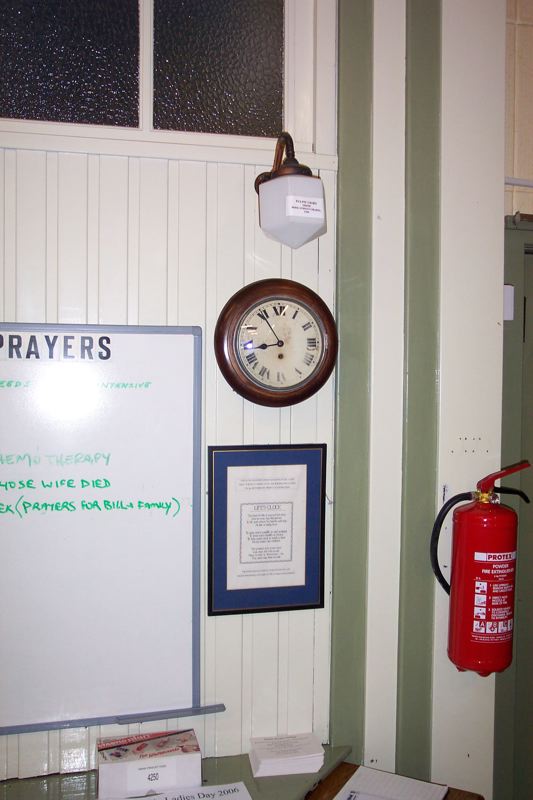
This clock hung on the wall at Rose Street Chapel
when Alexander Campbell preached there in 1847
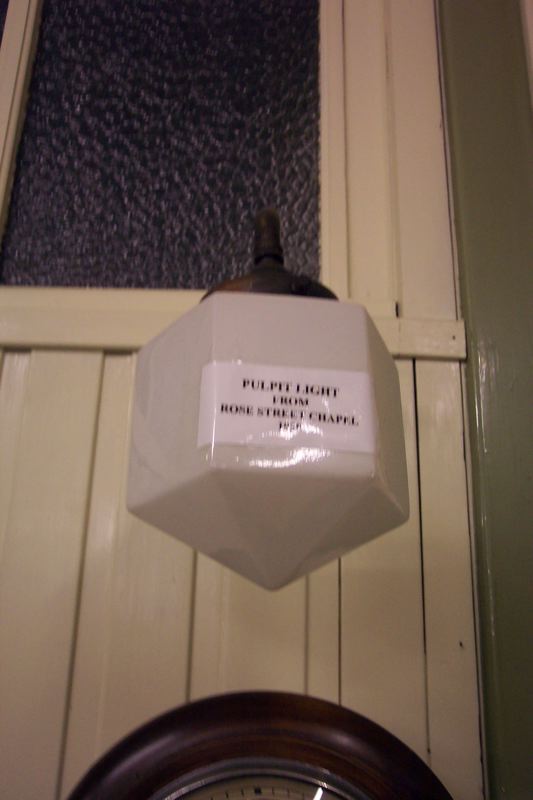
Pulpit Light
From
Rose Street Chapel
1956
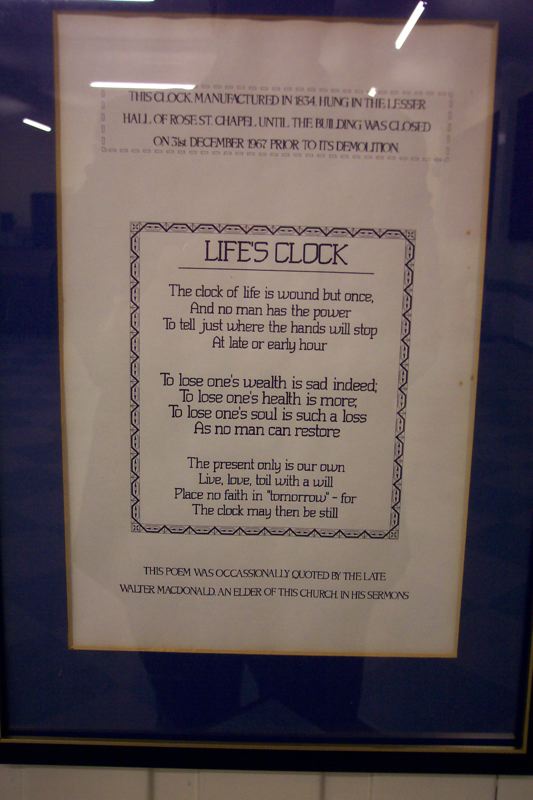
This clock manufactured in 1834, hung in the lesser
hall of Rose St. Chapel until the building was closed
on 31st December, 1967, prior to its demolition
Life's Clock
The clock of life is wound but once,
And no man has the power
To tell just where the hands will stop
At late or early hour
To lose one's wealth is sad indeed;
To lose one's health is more;
To lose one's soul is such a loss
As no man can restore
The present only is our own
Live, love, toil with a will
Place no faith in "tomorrow" - for
The clock may then be still
This poem was occasionally quoted by the late
Walter MacDonald, an elder of this church in his sermons.
![]()
Posters Hung Around Scotland During Alexander Campbell's 1847 Visit To Scotland
He was falsely accused, arrested, and jailed for 10 days in Duke Street Prison, Glasgow

Scott Harp with Robert W. Hughes, Historian, Long Time Member At Kirkaldy And Author of
Churches of Christ in the County of Fife, Scotland
Framed Posters Posted All Around Scotland in 1847
During The Visit of Alexander Campbell
Framed Posters Posted All Around Scotland in 1847
During The Visit of Alexander Campbell
Framed Posters Posted All Around Scotland in 1847
During The Visit of Alexander Campbell
![]()
Pulpit As It Looked In The Rose Street Chapel Building
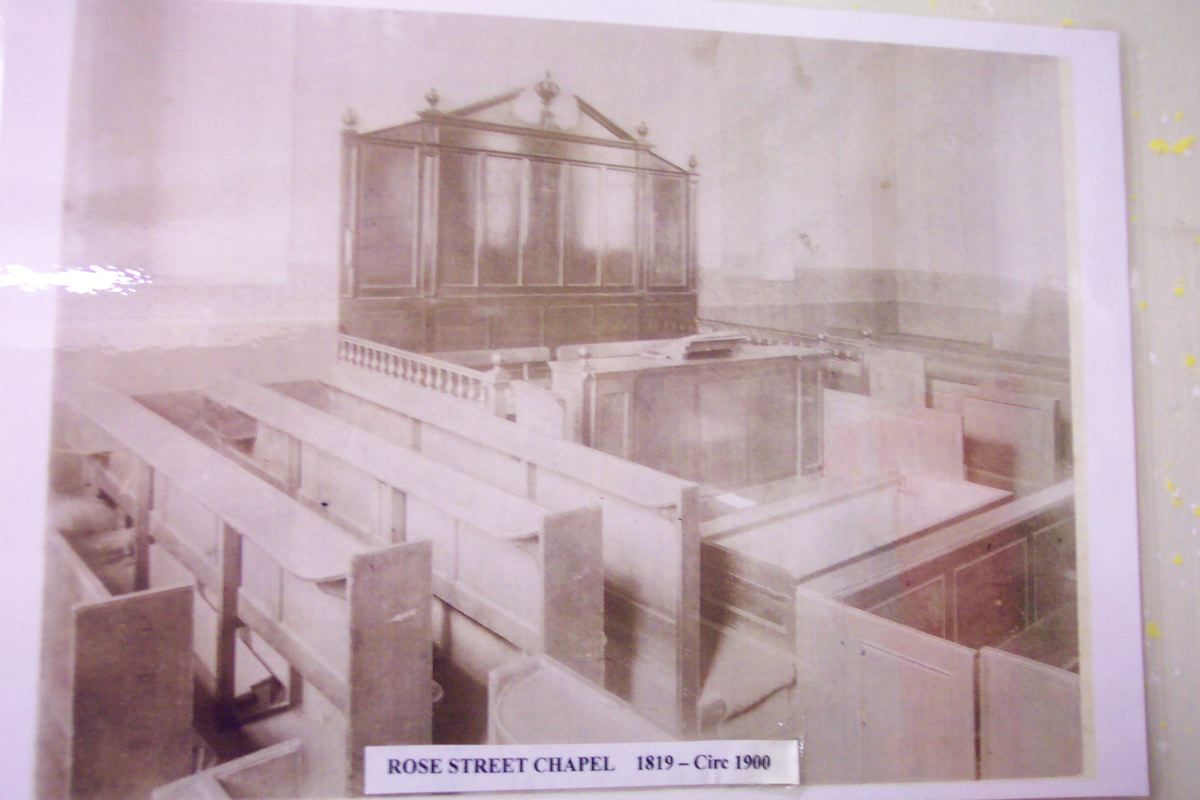
Alexander Campbell preached here between the 6th and 8th of August, 1847
![]()
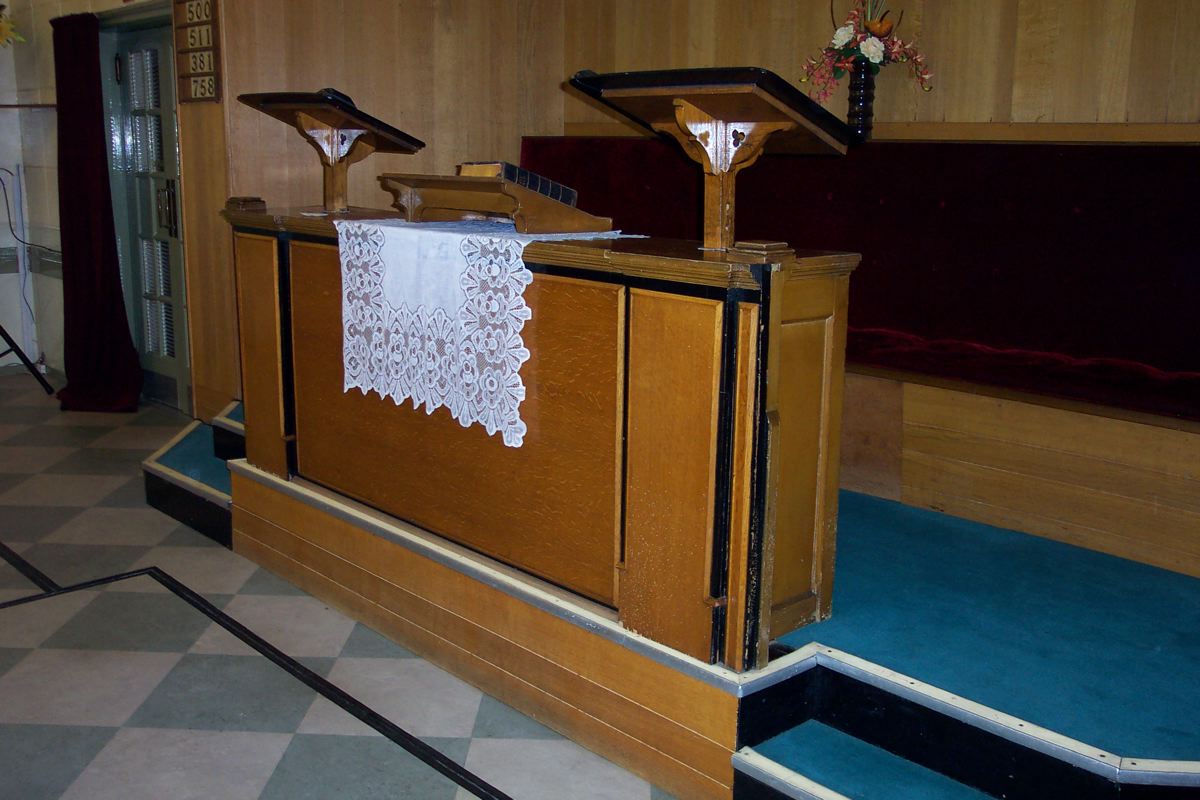
This Pulpit Has Been Used Since The Early 1800s
Most noted to preach from it is Alexander Campbell
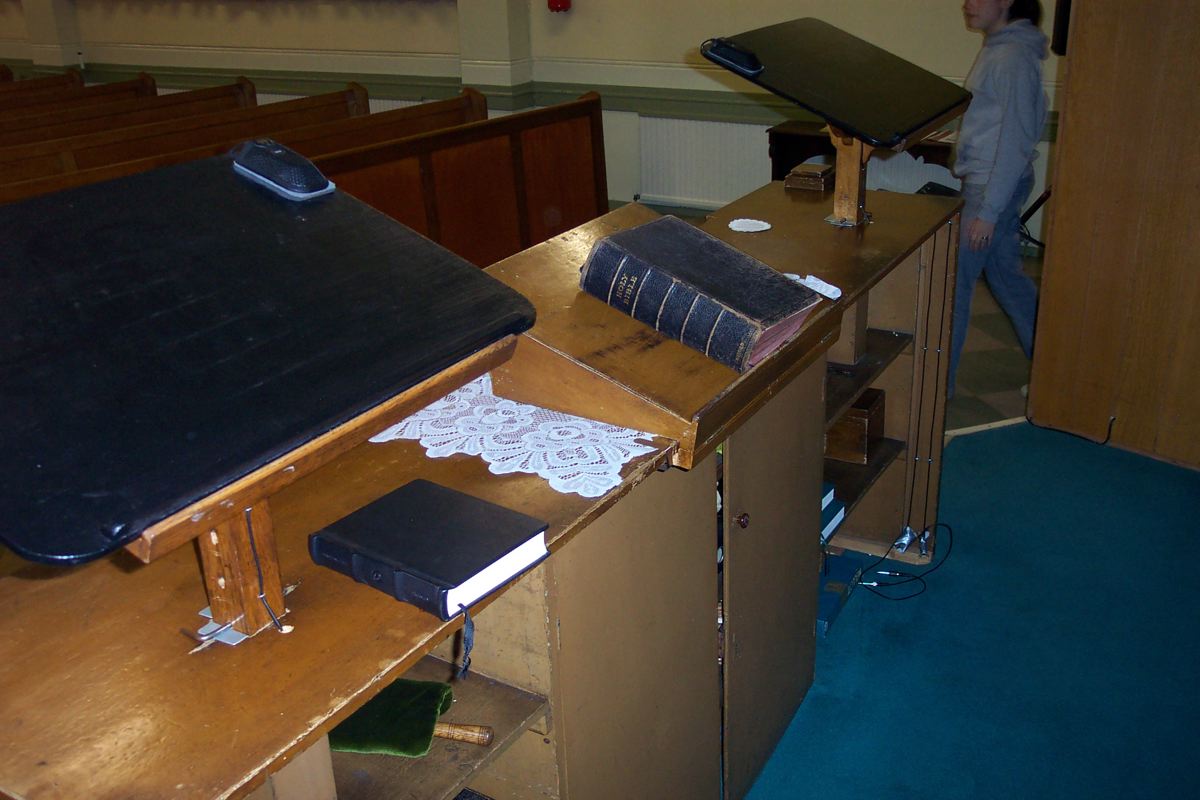
A Look Behind The Old Rose Street Chapel Pulpit
Now In The Building At Hayfield
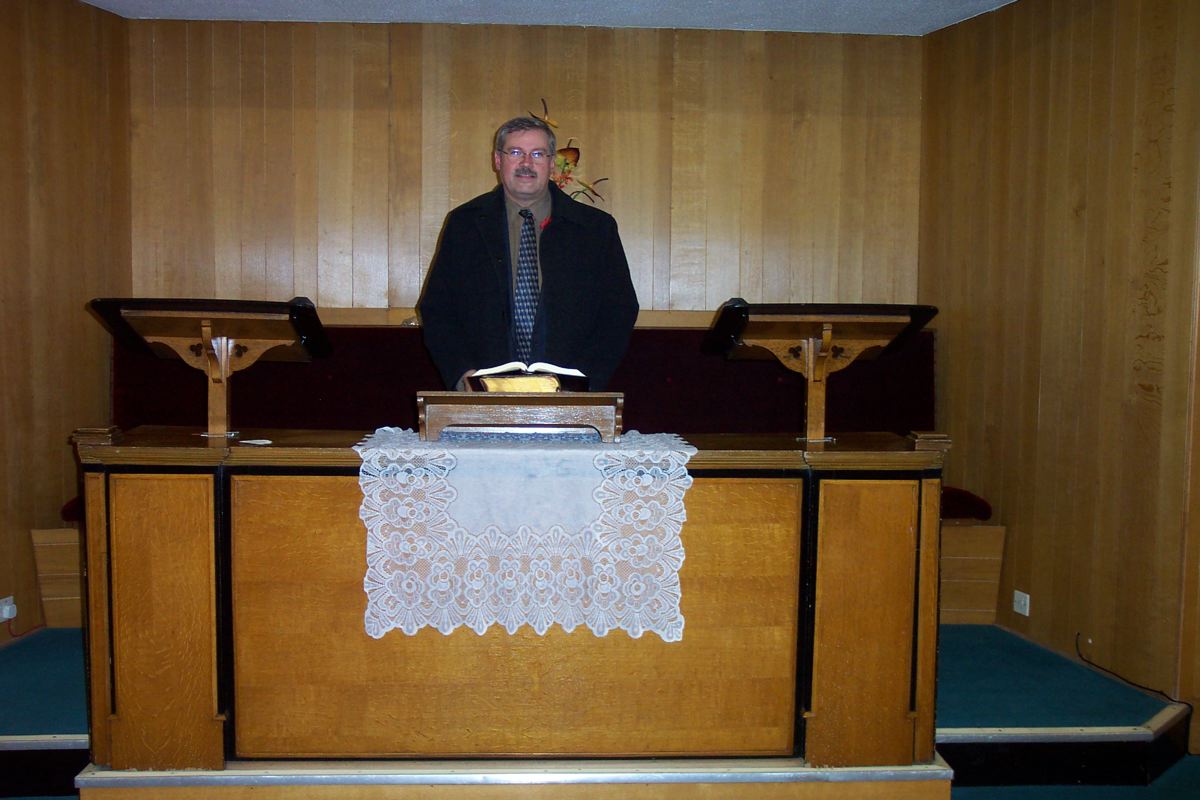
Your Web Editor, Scott Harp
In The Pulpit From Which Alexander Campbell
Preached In 1847
![]()
Photos Taken November, 2006
Courtesy of Scott Harp
www.TheRestorationMovement.com
![]()
